The wisdom of elders
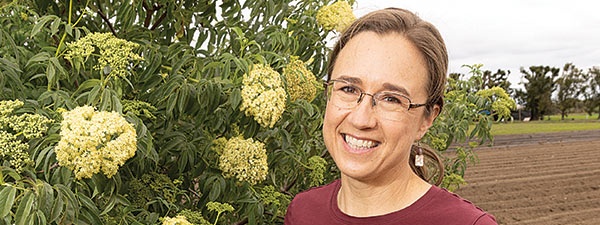
November/December 2023 California Bountiful magazine
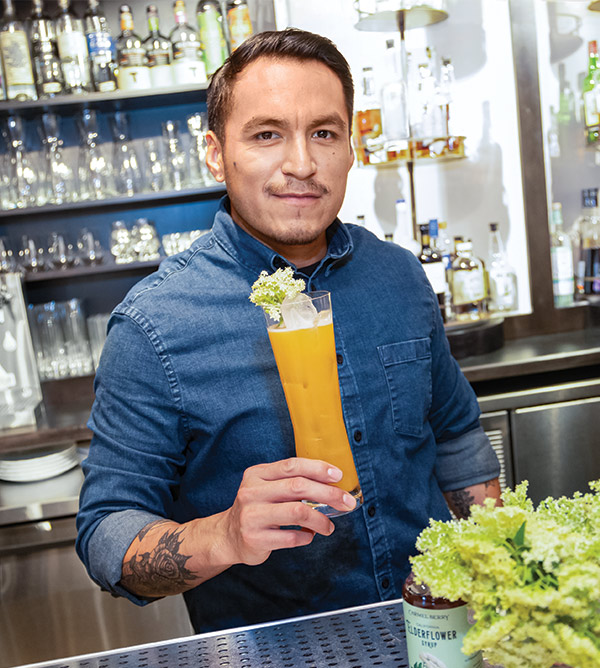
How California’s native elderberries became a sweet and sustainable business
Story by Caitlin Fillmore
Photos by Richard Green
The menu at Foray, one of Carmel-by-the-Sea’s newest restaurants, highlights the range of ingredients sourced and foraged solely from the West Coast.
The bar program, however, embraces a wide-ranging, global approach.
An ingredient that spans both sides of Foray’s meticulously chosen menus is the native and common, yet indescribably unfamiliar, elderberry and elderflower.
California-sourced fresh elderflower appears on pastries from Foray’s dessert menu and is infused into the panna cotta. Ivan Reyes, Foray’s bar director, mixes elderflower syrup into mocktails and cocktails. He also uses the blossoms as a botanical garnish. “The unique flavors and aromas are priceless,” he says. Reyes developed a popular mocktail combining the restaurant’s house-made apricot jelly with elderflower cordial.
“Non-alcoholic drinkers are normally looking for the equivalent of a cocktail without alcohol. Elderflower has a delicate flavor that allows you to make a complex drink,” says Foray general manager Caroline Singer, who owns the business with her husband, chef Michael Chang.
To maintain the couple’s vision of serving only high-quality and West Coast-sourced ingredients on the restaurant and bar menus, Singer discovered Katie Reneker and Carmel Berry Co. For about five years, Reneker has provided a source of West Coast elderberry and elderflower syrups, preserves and supplements to restaurants and individuals looking for this in-demand culinary and wellness ingredient.
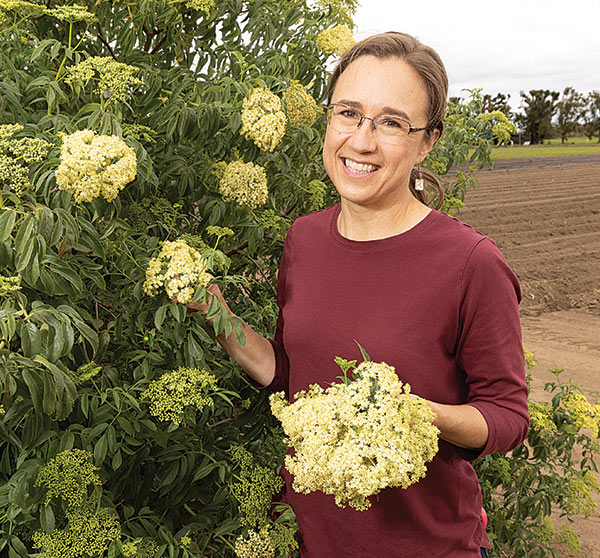
Trial and error
When Reneker began foraging for elderberries, she was a mom with young kids.
“I was looking for ways to naturally support our family’s immune system,” she recalls. “I started my business by finding wild trees and starting to experiment with them.”
Elderberry grows as a towering tree or shrub, first blooming with elderflowers in early spring. Elderflowers appear as compact bunches of cream-colored flowers that taste like “sunshine,” Reneker says. Elderflowers become elderberries by summer—small, round berries that resemble a blueberry but taste like a tart and sweet blueberry-pomegranate cross.
Within a few years of diligent foraging, Reneker had expanded her company enough that she needed to find a commercial source of a larger volume of berries. As in California, elderberries grow abundantly throughout Europe and the Midwest. But most elderberry products in the United States source dried berries from overseas. Large-scale production of elderberries does not exist on the West Coast.
Reneker wanted to prioritize finding fresh berries and flowers as close to her Carmel Valley headquarters as possible. She turned first to farming, attempting to grow her own test plots of the native West Coast blue elderberry, or Sambucus caerulea. After a 3-acre plot in south Monterey County finally matured enough to harvest, the land was sold and Reneker’s supply vanished again.
“It can be super frustrating to be the first person to try things. I can’t even describe how much has been lost,” she says. “But all the failures I experienced in those three years were super helpful in switching to (thinking), ‘How can we move the native blue elderberry forward?’”
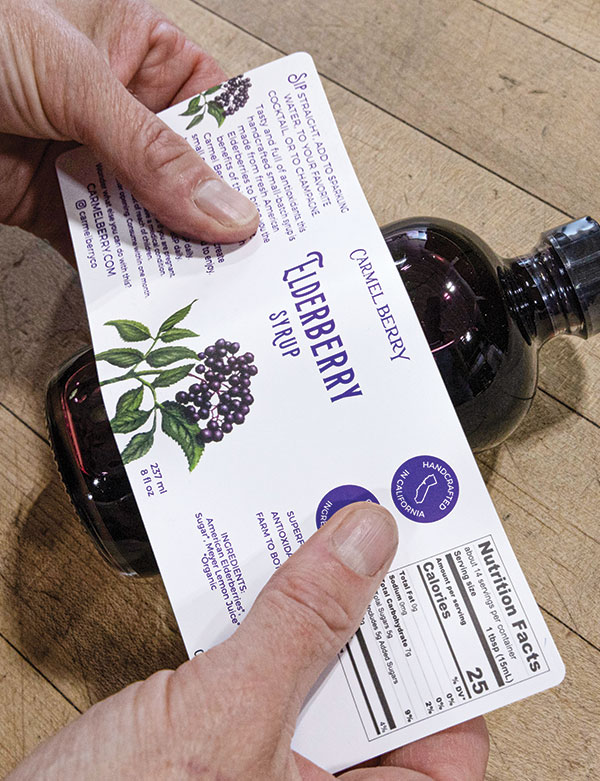
Sharing the berries
Today Reneker runs Carmel Berry Co., a line of culinary and wellness products. She uses fresh-pressed, certified organic American elderberries for preserves, teas, syrups, balsamic vinegars and supplements. Carmel Berry Co. products are sold in specialty grocery stores, including Whole Foods in Northern California and Erewhon in Southern California.
Reneker purchases 8,000 pounds of elderberries and 20 pounds of dried elderflowers from American producers each year. However, all of these products come from elderberries sourced outside the West Coast, which presents Reneker’s next ambitious goal.
Instead of farming, Reneker turned her attention to becoming an elderberry advocate and mentor to new and existing farmers. She began holding educational workshops during the COVID-19 pandemic, drawing 300 people and counting. She independently funds $500 microgrants to help landowners invest in elderberries. This helps maintain an important part of Carmel Berry Co.’s mission, where “a part of our sales goes to support the growers,” Reneker says. These grants have funded projects like installing fencing and irrigation. Her company has invested more than $12,000 in fellow elderberry farmers so far.
“There’s a lot of work that needs to be done to make it financially possible for someone to get into elderberries,” Reneker says. “But the collaboration going on in the elderberry world is super heartening and exciting. Now we have a really great network of growers up and down the West Coast.”
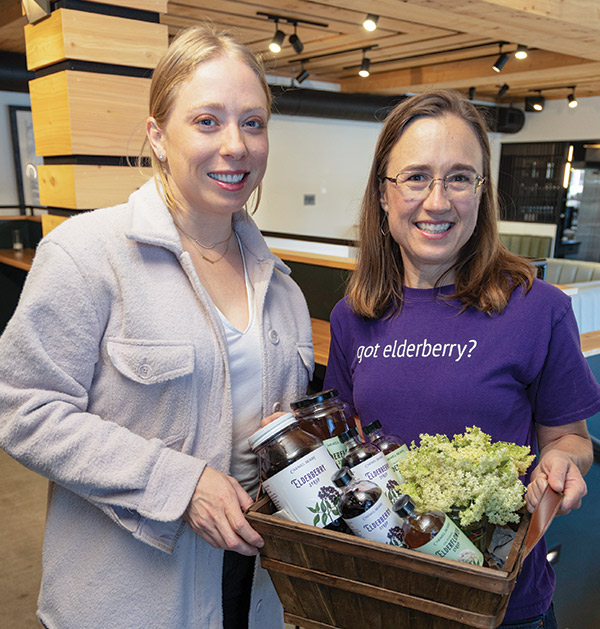
Sweet and sustainable
Aside from syrups and supplements, the elderberry plant itself serves as an environmentally friendly addition to California landscapes. Part of Reneker’s advocacy with entities such as the University of California, Davis now involves educating farmers on the benefits of including a native elderberry hedgerow.
According to the UC Agriculture and Natural Resources website, elderberries can be planted as a native hedgerow to serve as a natural boundary or fencing. Elderberry hedgerows support the insect and bird species that can help farmers naturally control pests. Wildlife finds refuge in elderberry hedgerows, too, like honeybees and other useful pollinators. Because it is a native plant, elderberries are drought-resistant and grow in a wide range of climates.
Hedgerows like these are also part of the future for California’s emerging elderberry sector. After her early challenges with growing and sourcing elderberries, Reneker has found the right balance for Carmel Berry Co. She partners with farmers who choose to plant elderberries as part of their native hedgerows. “My goal is to keep supporting that work,” Reneker says.
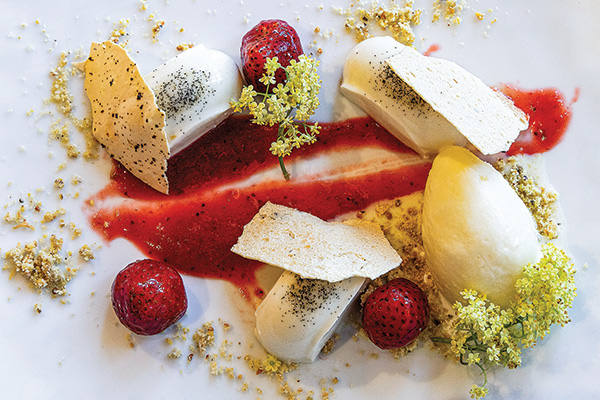
The elderberry boost
Even in Carmel Berry Co.’s earliest days, when Reneker was still trading homemade syrups with neighbors who let her forage for the native plant, the wellness benefits of elderberries ranked as a top priority for the business.
“I believe food is our medicine and healthy things should be delicious,” Reneker says. “Elderberries have a foot in both categories.”
Elderberries contain calcium, iron and vitamins A, C and B6. The berries contain high levels of various antioxidants, which may contribute to heart health. Some small-scale studies have found elderberry syrup could help fight colds and flu and relieve inflammation.
As Carmel Berry Co. continues to evolve, the foundational wellness aspect of elderberries remains a priority for Reneker. Next the company plans to debut an elderberry gummy with a high concentration of elderberry, she says.
“People love gummies as a way to have nutritional support. We have been working hard to create a gummy that will be really high in American elderberry with no sugar or sugar alcohol,” says Reneker, who notes that most elderberry supplements on shelves source European elderberry instead of domestic berries.
Perhaps there is no more mainstream wellness trend today than juicing, with juice bars popping up inside natural food grocery stores. Reneker says Carmel Berry Co.’s elderberry syrups will soon be part of the juice bars inside the Bristol Farms chain of stores in Southern California, which includes Lazy Acres and New Leaf Community Markets.
These partnerships with grocery stores and restaurants like Foray in Carmel-by-the-Sea represent a demand for elderberry and elderflower products throughout California. “Partnering with people who value the ingredients being high quality and sustainably made is a dream for small producers like me,” Reneker says.
Identifying and using foraged elderberries
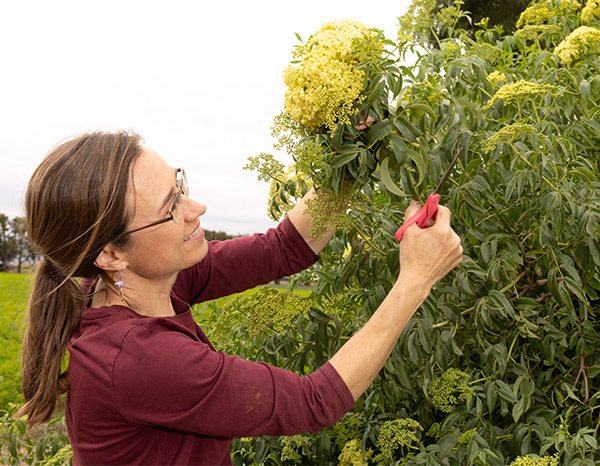
Elderberry is native to almost every continent and has been used for food and medicine for generations, says Katie Reneker, elderberry advocate and founder of Carmel Berry Co. While Reneker is someone who naturally tries to identify every plant or crop she passes, her tips can help others identify elderflowers and elderberries where they live. “As soon as I knew what to look for, I started recognizing it literally all over our valley,” she says.
Elderberries can grow as a large shrub or even into a tree, between 12 and 25 feet tall. The elderberry tree has wrinkled bark and hollow branches. Starting in the spring, small cream-colored flowers cover the entire tree. These mature into blue elderberries in August. Because elderberries are still a wild plant, the quality of berries is inconsistent. Squeeze the berries gently before picking and look for a slightly pink juice for a better chance of getting ripe berries.
Remember: Elderflowers grow from a tall shrub or tree. Hemlock looks very similar to elderflowers, but these grow directly out of the ground. Avoid hemlock as it is toxic to people and pets, both when ingested and inhaled.
Snip off an entire cluster of elderberries or elderflowers and cook the berries into jelly or bake into muffins. Dry the flowers for tea or sprinkle into pancakes. Elderberries must be cooked before eating and work best when combined with other berries. Try combining with blueberries, both for a balanced, sweet flavor and for needed pectin. Elderberries do not contain pectin starch.
- Foray's elderflower mocktail or cocktail
-
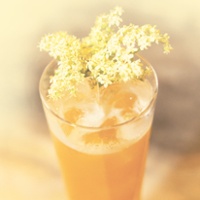
-
This versatile Foray creation, from bar director Ivan Reyes, uses the unique flavors of elderflower to create a drink with depth. The addition of apricot jelly “gives a nice texture and balance that I think mocktail drinkers are looking for,” says Foray co-owner Caroline Singer.

